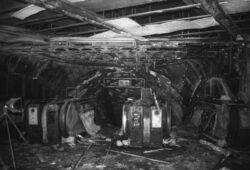Julie Bush was held back from the fire by a mystery station worker (Picture: PA)
On November 18, 1987, hundreds of people were making their way through King’s Cross St Pancras underground station.
It was a typical bustling scene still seen every evening in London.
Smoking had recently been banned on the Underground, but weary commuters often took advantage of the escalator journey from platforms to spark up early.
Around 7.30pm, one smoker lit a cigarette on their way from the Piccadilly service platforms to the forecourt of the station.
The commuter discarded their lit match, which fell through a gap in the wooden escalator, and landed on a built-up pile of grease and litter.
Small embers grew into large flames and, around 15 minutes later, erupted into a fireball that claimed the lives of 31 people.
The blast of fire burst through the station, with people forced to duck for cover and battle to escape amid thick smoke.
Molten plastic dripped from the ceiling and concrete cracked due to the intensity of the heat.
The blaze began at 7.30pm on 18 November 1987 (Picture: Paul Massey/Daily Mirror/Mirrorpix/Getty Images)
Julia Bush, then 25, tried to access the station as the flames first took hold – and was guided away by a mystery station worker.
Speaking on the 35th anniversary of the tragedy, she told Metro.co.uk: ‘I was at Kings Cross shortly after the fire must have started. I’d tried to go down the stairs to the station but a member of the station staff suggested I wait a bit as they were waiting for the fire brigade to put out a small fire.
‘I watched as the first fire engines arrived and the fire fighters descended the stairs little knowing that some would never come out.
‘I hung around for a little while but more engines arrived so headed away from the station to pick up a taxi.’
Julie Bush, pictured here aged 25, narrowly avoided the blaze (Picture: Julie Bush)
Julia, who now lives in Buntingford, Hertfordshire, would love to thank her unknown hero in person.
She added: ‘I don’t know who that member of staff was that evening, but I do know without his wise words I almost certainly would not be here today. Thank you doesn’t seem enough.’
Elsewhere in London, Kathy Taylor had been waylaid leaving her work on November 18.
Running late may well have saved her life.
A lit match dropped on a wooden escalator started the fire (Picture: Paul Massey/Daily Mirror/Mirrorpix/Getty Images)
A prolonged tongue of fire and smoke then had burst up into the ticket hall (Picture: PA)
Kathy had already experienced a emotion-fuelled week already with a several long nights at her job, her 20th birthday and the suicide of a friend’s brother-in-law.
She left her office, opposite St James’ Park tube station, and travelled to Victoria, before changing onto the Victoria Line en route to King’s Cross to catch the 7.05pm train to Hitchin.
Kathy told Metro.co.uk: ‘As the tube pulled into Euston, the stop before Kings Cross, an announcement was made; it was so chilling that everyone listened.
‘We were asked to quickly get off the train and make our way to the surface so that the train could proceed quickly to Kings Cross where there was an emergency.
An inquiry was then ordered into the cause (Picture: Paul Massey/Daily Mirror/Mirrorpix/Getty Images)
‘I helped an elderly lady to the mainline station and, with her, joined the queue to phone home, this was before most normal folk had mobiles. Many people didn’t have change so 10p coins were shared freely.’
Kathy eventually caught a train to Luton where her husband met her, and informed her of the scale of the emergency she had narrowly missed.
Trains continued to run on the Victoria Line the following day, much to the surprise of commuters.
But Kathy added that a ‘respectful silence’ was observed as she and her other passengers’ carriage made its way passed the closed St Pancreas station.
‘I still wonder whether I might have been directly affected by the fire if I’d left the office a few minutes earlier. Who knows?’ mused Kathy.
After the King’s Cross station fire was brought under control, around 9:48pm, search and salvage operations continued throughout the night.
A public inquiry into the incident was initiated by then Prime Minister Margaret Thatcher after she visited the station.
It was conducted by Desmond Fennell OBE QC, assisted by a panel of four expert advisers.
Margaret Thatcher visited the scene of the fire (Picture: Keystone/Hulton Archive/Getty Images)
The inquiry opened at Central Hall, Westminster on 1 February 1988 and closed on 24 June, after hearing 91 days of evidence.
London Underground were strongly criticised in the report for their attitude to fires underground, underestimating the hazard because no one had died in a fire on the Underground before
The body was recommended to investigate ‘passenger flow and congestion in stations and take remedial action’ and improvements were later made.
Consequently, parliamentary bills were tabled to permit London Underground to improve and expand the busiest and most congested stations, such as London Bridge, Tottenham Court Road, Holborn and King’s Cross St Pancras.
What did it change?
A public inquiry by Sir Desmond Fennell published in November 1988, made 157 recommendations including:
Replacing wooden escalators.
The smoking ban extended to all station areas.
Radio equipment used by British Transport Police to be compatible with those of the Brigade.
A review of the Brigade’s Personal Protective Equipment (PPE).
Improvement to the Brigade’s radio communications between firefighters below ground.
Plans to be kept outside stations in locations agreed with the Brigade.
Review of training and policy.
Among the legacy of safety changes the fire brought about, the 35th anniversary of the fire also serves the chance to remember the heroes who stopped the death toll rising even further.
Brave station staff had helped direct passengers away from the flames until firefighters arrived on the scene and battled to quell the blaze.
Thick smoke had engulfed the station’s ticket hall, obscuring the exits and hampering initial rescue efforts.
Among those who lost their lives in the fire was Soho’s Station Officer Colin Townsley.
Firemen in the forecourt of the station (Picture: John Downing/Getty Images)
His body was found next to a fatally injured passenger at the steps leading up to the Pancras Road entrance of the station.
Passengers had spoke of a man matching his description telling people to get out moments before the flashover occurred.
A report into the fire later stated: ‘Station Officer Townsley was overcome by smoke and fumes while trying to help the burned passenger… a heroic act.’
His legacy, 35 years on, is still widely known within firefighters.
The fire led to huge changes and safety regulations in stations (Picture: PA)
At Soho Fire Station, Station Officer Townsley’s space remains empty in memory of the fallen firefighter – and the members of the public who lost their lives that terrible day.
Deputy Commissioner Jonathan Smith told Metro.co.uk: ‘On the 35th anniversary of the worst fire ever to occur on the London Underground our thoughts are with all the victims and their family and friends.
‘In particular, we remember Station Officer Colin Townsley who died while trying to help passengers. The fire is a landmark in leading to improvements in firefighters’ uniform, underground fire safety procedures and joint working between emergency services.
‘These changes have improved safety on the underground to the benefit of the public and firefighters.’
Get in touch with our news team by emailing us at [email protected].
For more stories like this, check our news page.
Metro.co.uk spoke to survivors of the terrifying fire that ripped through King’s Cross St Pancras on November 18, 1987.





